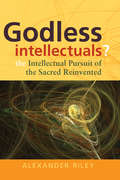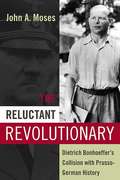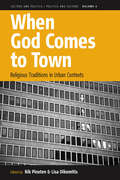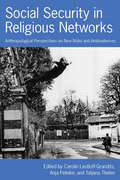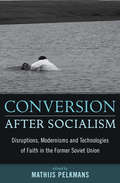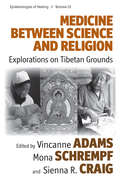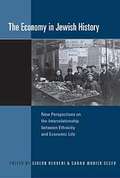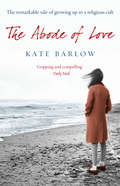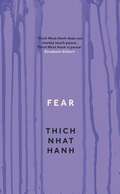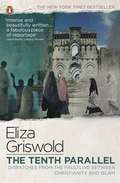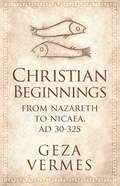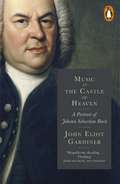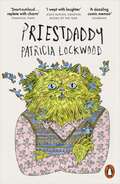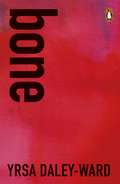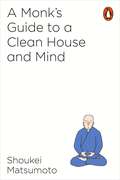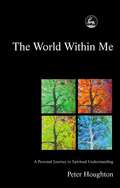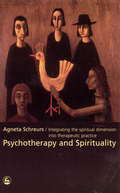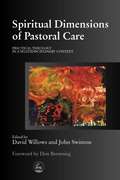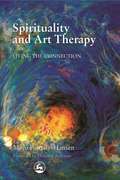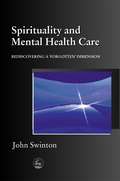- Table View
- List View
Godless Intellectuals?: The Intellectual Pursuit of the Sacred Reinvented
by Alexander Tristan RileyThe Durkheimians have traditionally been understood as positivist, secular thinkers, fully within the Enlightenment project of limitless reason and progress. In a radical revision of this view, this book persuasively argues that the core members of the Durkheimian circle (Durkheim himself, Marcel Mauss, Henri Hubert and Robert Hertz) are significantly more complicated than this. Through his extensive analysis of large volumes of correspondence as well as historical and macro-sociological mappings of the intellectual and social worlds in which the Durkheimian project emerged, the author shows the Durkheimian project to have constituted a quasi-religious quest in ways much deeper than most interpreters have thought. Their fascination, both personal and intellectual, with the sacred is the basis on which the author reconstructs some important components of modern French intellectual history, connecting Durkheimian thought to key representatives of French poststructuralism and postmodernism: Bataille, Foucault, Derrida, Baudrillard, and Deleuze.
The Reluctant Revolutionary: Dietrich Bonhoeffer's Collision with Prusso-German History
by John A. MosesDietrich Bonhoeffer was a uniquely reluctant and distinctly German Lutheran revolutionary. In this volume, the author, an Anglican priest and historian, argues that Bonhoeffer’s powerful critique of Germany’s moral derailment needs to be understood as the expression of a devout Lutheran Protestant. Bonhoeffer gradually recognized the ways in which the intellectual and religious traditions of his own class - the Bildungsbürgertum - were enabling Nazi evil. In response, he offered a religiously inspired call to political opposition and Christian witness—which cost him his life. The author investigates Bonhoeffer’s stance in terms of his confrontation with the legacy of Hegelianism and Neo-Rankeanism, and by highlighting Bonhoeffer’s intellectual and spiritual journey, shows how his endeavor to politicially reeducate the German people must be examined in theological terms.
When God Comes to Town: Religious Traditions in Urban Contexts (Culture and Politics/Politics and Culture #4)
by Rik Pinxten and Lisa DikomitisAround 1800 roughly three per cent of the human population lived in urban areas; by 2030 this number is expected to have gone up to some seventy per cent. This poses problems for traditional religions that are all rooted in rural, small-scale societies. The authors in this volume question what the possible appeal of these old religions, such as Christianity, Judaism, or Islam could be in the new urban environment and, conversely, what impact global urbanization will have on learning and on the performance and nature of ritual. Anthropologists, historians and political scientists have come together in this volume to analyse attempts made by churches and informal groups to adapt to these changes and, at the same time, to explore new ways to study religions in a largely urbanized environment.
Social Security in Religious Networks: Anthropological Perspectives on New Risks and Ambivalences
by Carolin Leutloff-Grandits Anja Peleikis Tatjana ThelenDuring the last decades, the world has been facing tremendous political transformations and new risks: epidemics such as HIV/Aids have had destabilizing effect on the caretaking role of kin; in post-socialist countries political reforms have made unemployment a new source of insecurity. Furthermore, the state’s withdrawal from providing social security is taking place throughout the world. One response to these developments has been increased migration, which poses further challenges to kinship-based social support systems. This innovative volume focuses on the ambiguous role of religious networks in social security and traces the interrelatedness of religious networks and state and family support systems. Particularly timely, it describes these challenges as well as social security arrangements in the context of globalization and migration. The wide range of case studies from various parts of the world that examine various religious groups offers an important comparative contribution to the understanding of religious networks as providers of social security.
Conversion After Socialism: Disruptions, Modernisms and Technologies of Faith in the Former Soviet Union
by Mathijs PelkmansThe large and sudden influx of missionaries into the former Soviet Union after seventy years of militant secularism has been controversial, and the widespread occurrence of conversion has led to anxiety about social and national disintegration. Although these concerns have been vigorously discussed in national arenas, social scientists have remained remarkably silent about the subject. This volume’s focus on conversion offers a novel approach to the dislocations of the postsocialist experience. In eight well researched ethnographic accounts the authors analyze a range of missionary encounters as well as aspects of conversion and "anti-conversion" in different parts of the region, thus challenging the problematic idea that religious life after socialism involved a simple "revival" of repressed religious traditions. Instead, they unravel the unexpected twists and turns of religious dynamics, and the processes that have challenged popular ideas about religion and culture. The contributions show how conversion is rooted in the disruptive qualities of the new "capitalist experience" and document its unsettling effects on the individual and social level.
Medicine Between Science and Religion: Explorations on Tibetan Grounds (Epistemologies of Healing #10)
by Vincanne Adams, Mona Schrempf and Sienna R. CraigThere is a growing interest in studies that document the relationship between science and medicine - as ideas, practices, technologies and outcomes - across cultural, national, geographic terrain. Tibetan medicine is not only known as a scholarly medical tradition among other Asian medical systems, with many centuries of technological, clinical, and pharmacological innovation; it also survives today as a complex medical resource across many Asian nations - from India and Bhutan to Mongolia, Tibet (TAR) and China, Buryatia - as well as in Western Europe and the Americas. The contributions to this volume explore, in equal measure, the impacts of western science and biomedicine on Tibetan grounds - i.e., among Tibetans across China, the Himalaya and exile communities as well as in relation to globalized Tibetan medicine - and the ways that local practices change how such “science” gets done, and how this continually hybridized medical knowledge is transmitted and put into practice. As such, this volume contributes to explorations into the bi-directional flows of medical knowledge and practice.
The Economy in Jewish History: New Perspectives on the Interrelationship between Ethnicity and Economic Life
by Gideon Reuveni Sarah Wobick-SegevJewish historiography tends to stress the religious, cultural, and political aspects of the past. By contrast the “economy” has been pushed to the margins of the Jewish discourse and scholarship since the end of the Second World War. This volume takes a fresh look at Jews and the economy, arguing that a broader, cultural approach is needed to understand the central importance of the economy. The very dynamics of economy and its ability to function depend on the ability of individuals to interact, and on the shared values and norms that are fostered within ethnic communities. Thus this volume sheds new light on the interrelationship between religion, ethnicity, culture, and the economy, revealing the potential of an “economic turn” in the study of history.
The Abode of Love: The Remarkable Tale of Growing Up in a Religious Cult
by Kate BarlowThe Abode of Love is Kate Barlow's remarkable account of growing up within the remnants of a religious cult.Protected from the truth about her family's past by a wall of secrecy, it was years before Kate unearthed her grandfather's controversial claim to be the reincarnation of Jesus Christ and learned of the rumours that had circulated within the local Somerset community of sexual scandals, 'spiritual brides' and peculiar rituals.This is the gripping story of how one woman pieced together a hidden family history and uncovered a more shocking truth than she ever imagined.
Fear: Essential Wisdom for Getting Through The Storm
by Thich Nhat HanhRenowned Zen master and Buddhist monk, Thich Nhat Hanh, explores the origins of fear and offers detailed practises on how to deal with its often toxic presence in our lives. Formed by a lifetime of mindfulness in action, he also shows us the path to peace, happiness and freedom that can come out of such explorations. For him, happiness is not found by suppressing our emotions but by purposefully living in a mindfully aware state. Only by practicing mindfulness in this way can we identify the source of pain that is responsible for our fear and anxiety, and cut it off from its roots so that the pain can subside. When we're not held in the grip of fear, we can truly embrace the gifts of life.
The Tenth Parallel: Dispatches from the Faultline Between Christianity and Islam
by Eliza GriswoldThe tenth parallel - the line of latitude seven hundred miles north of the equator - is a geographical and ideological front line where Christianity and Islam collide. Across much of inland Africa and Asia, from Nigeria, Sudan and Somalia to Indonesia, Malaysia and the Philippines, live more than half of the world's 1.3 billion Muslims, and sixty percent of the world's 2 billion Christians. The space between the equator and the tenth parallel marks the end of Africa's arid north and the beginning of sub-Saharan jungle; in Southeast Asia, the encounter between the two religions is also driven by wind and weather, as the trade winds carried merchants of both faiths across the sea, and the clash of hot and cold air creates the hurricanes that travel across the earth to hit Latin and North American soil. On both sides of the line, the religions and their people are experiencing reawakenings of faith - and in their buzzing megacities and swarming jungle, the encounters between the two faiths is shaping the future.Eliza Griswold, award-winning investigative journalist and poet, has spent the past seven years travelling the space between the equator and the tenth parallel, exploring the meanings and ramifications of this reawakening of faith, in a place where these changes may alter the future of what's called the Global South - and, in turn, the West. In each country along the faultline, she asks if it is possible to determine where faith ended and secular violence began, or what role religion actually plays in struggles over resources and political power. The story of this encounter between religions unfolds over nearly two thousand years and more than 600,000 square miles.An urgent examination of the relationship between faith and worldly power, The Tenth Parallel is an essential work about the conflicts over religion, nationhood and natural resources that will remake the world in the years to come.
Christian Beginnings: From Nazareth to Nicaea, AD 30-325
by Geza VermesGeza Vermes, translator and editor of The Complete Dead Sea Scrolls and worldwide expert on the life and times of Jesus, tells the enthralling story of early Christianity and the origins of a religion. The creation of the Christian Church is one of the most important stories in the development of the world's history, but also one of the most enigmatic and little understood, shrouded in mystery and misunderstanding. With a forensic, brilliant re-examination of all the key surviving texts of early Christianity, Geza Vermes illuminates the origins of a faith and traces the evolution of the figure of Jesus from the man he was - a prophet fully recognisable as the successor to other Jewish holy men of the Old Testament - to what he came to represent: a mysterious, otherworldly being at the heart of a major new religion. As Jesus's teachings spread across the eastern Mediterranean, hammered into place by Paul, John and their successors, they were transformed in the space of three centuries into a centralised, state-backed creed worlds away from its humble origins. Christian Beginnings tells the captivating story of how a man came to be hailed as the Son consubstantial with God, and of how a revolutionary, anti-conformist Jewish sub-sect became the official state religion of the Roman Empire.Reviews:'A beautiful and magisterial book' Rowan Williams, Archbishop of Canterbury, Guardian'An exciting and challenging port of call, sweeping aside much of the fuzzy thinking and special pleading that bedevils the study of sacred scripture ... courteously expressed and witty' Diarmaid MacCulloch, The Times'A challenging and engaging book that sets out to retrace the route by which a Jewish preacher in 1st-century Israel came to be declared as consubstantial and co-equal with the omnipotent, omniscient only God' Stuart Kelly, Scotsman'A major contribution to our understanding of the historical Jesus' Financial Times'A very accessible and entertaining read' Scotland on Sunday Books of the Year'A magnum opus of early Christian history and one of the year's most significant titles' Bookseller
Music in the Castle of Heaven: A Portrait of Johann Sebastian Bach
by John Eliot GardinerJohann Sebastian Bach is one of the most unfathomable composers in the history of music. How can such sublime work have been produced by a man who (when we can discern his personality at all) seems so ordinary, so opaque - and occasionally so intemperate?John Eliot Gardiner grew up passing one of the only two authentic portraits of Bach every morning and evening on the stairs of his parents' house, where it hung for safety during the Second World War. He has been studying and performing Bach ever since, and is now regarded as one of the composer's greatest living interpreters. The fruits of this lifetime's immersion are distilled in this remarkable book, grounded in the most recent Bach scholarship but moving far beyond it, which explains in wonderful detail the ideas on which Bach drew, how he worked, how his music is constructed, how it achieves its effects - and what it can tell us about Bach the man.Gardiner's background as a historian has encouraged him to search for ways in which scholarship and performance can cooperate and fruitfully coalesce. This has entailed piecing together the few biographical shards, scrutinising the music, and watching for those instances when Bach's personality seems to penetrate the fabric of his notation. Gardiner's aim is 'to give the reader a sense of inhabiting the same experiences and sensations that Bach might have had in the act of music-making. This, I try to show, can help us arrive at a more human likeness discernible in the closely related processes of composing and performing his music.'It is very rare that such an accomplished performer of music should also be a considerable writer and thinker about it. John Eliot Gardiner takes us as deeply into Bach's works and mind as perhaps words can. The result is a unique book about one of the greatest of all creative artists.SIR JOHN ELIOT GARDINER is one of the world's leading conductors, not only of Baroque music but across the whole repertoire. He founded the Monteverdi Choir and Orchestra, the Orchestre de l'Opéra de Lyon, the English Baroque Soloists, and the Orchestre Revolutionnaire et Romantique. He has conducted most of the world's great orchestras and in many of the leading opera houses. He lives and farms in Dorset.
Priestdaddy: A Memoir
by Patricia LockwoodNEW STATESMAN AND OBSERVER BOOKS OF THE YEAR 2017'Destined to be a classic . . . this year's must-read memoir' Mary Karr, author of The Liars' Club'Irrepressible . . . joyous, funny and filthy . . . Lockwood blows the roof off every paragraph' Joe Dunthorne, author of SubmarineThe childhood of Patricia Lockwood, the poet dubbed' The Smutty-Metaphor Queen of Lawrence, Kansas' by The New York Times, was unusual in many respects. There was the location: an impoverished, nuclear waste-riddled area of the American Midwest. There was her mother, a woman who speaks almost entirely in strange riddles and warnings of impending danger. Above all, there was her gun-toting, guitar-riffing, frequently semi-naked father, who underwent a religious conversion on a submarine and found a loophole which saw him approved for the Catholic priesthood by the future Pope Benedict XVI, despite already having a wife and children.When an unexpected crisis forces Lockwood and her husband to move back into her parents' rectory, she must learn to live again with the family's simmering madness, and to reckon with the dark side of her religious upbringing. Pivoting from the raunchy to the sublime, from the comic to the serious, Priestdaddy is an unforgettable story of how we balance tradition against hard-won identity - and of how, having journeyed in the underworld, we can emerge with our levity and our sense of justice intact.'Beautiful, funny and poignant. I wish I'd written this book' Jenny Lawson, author of Furiously Happy'A revelatory debut . . . Lockwood's prose is nothing short of ecstatic . . . her portrait of her epically eccentric family is funny, warm, and stuffed to bursting with emotional insight' Joss Whedon'Praise God, this is why books were invented' Emily Berry, author of Dear Boy and Stranger, Baby
bone
by Yrsa Daley-Ward Kiese Laymon'Yrsa's work is like holding the truth in your hands. A glorious living thing' Florence Welch'One of the must-reads of the year' Rohan Silva, Evening Standard'You will come away bruised.You will come away bruisedbut this will give you poetry.'Raw and stark, the poems in Yrsa Daley-Ward's breakthrough collection strip down her reflections on the heart, life, the inner self, coming of age, faith and loss to their essence. They resonate to the core of experience. 'yrsa daley-ward's 'bone' is a symphony of breaking and mending. an expert storyteller. of the rarest. and purest kind - daley-ward is uncannily attentive and in tune to the things beneath life. beneath the skin. beneath the weather of the everyday.' nayyirah waheed. author of salt. and nejma'Sharing is her form of survival ... A powerful collection of a woman facing tumultuous inner and external battles head on, delivered with a hard-hitting directness, yet with inflections of optimism throughout' i-D Magazine
A Monk's Guide to a Clean House and Mind: Housekeeping Secrets From The World's Tidiest Monks
by Shoukei MatsumotoCleanliness is next to enlightenment. In this Japanese bestseller a Buddhist monk explains the traditional cleaning techniques that will help cleanse not only your house - but your soul.'We remove dust to sweep away our worldly desires. We scrub dirt to free ourselves of attachments. We live simply and take time to contemplate the self, mindfully living each moment. It's not just monks that need to live this way. Everyone in today's busy world today needs it.The Zen sect of Buddhism is renowned for the cleanliness of its monks, but cleaning is greatly valued in Japanese Buddhism in general as a way to cultivate the mind. In this book, I introduce everyday cleaning methods typically employed in temples, while sharing what it's like to be a monk in training.This book will improve the condition not just of your own mind, but also the people around you. I hope readers will discover that cleanliness is an opportunity to contemplate oneself.'
Selling Shaker: The Promotion of Shaker Design in the Twentieth Century (Value: Art: Politics #1)
by Stephen Bowe Peter RichmondThe Shakers – a religious community whose origins are founded in the eighteenth century – continue to exert an influence upon twenty-first century life, not for their religious teachings but rather through the simple yet elegant aesthetic they developed for the everyday artefacts they designed for themselves. Selling Shaker aims to explore this influence and chart its evolution throughout the course of the twentieth century via the interest shown by the media, art institutions and general public in the Shaker story. Whilst other books have sought to examine the origins of the religious or aesthetic basis of the movement throughout the course of the eighteenth and nineteenth centuries, this book seeks to deal with the Shaker phenomenon from a different angle. Selling Shaker examines the means by which the Shakers have been ‘promoted’ during the course of the last century by scholars and museum academics in order to establish a ‘national’ style. The book follows this process from high art to popular culture influences illustrating how the Shaker style has entered the general design consciousness and in doing so has become a generic style largely divorced from the original Shaker aesthetic. Using a variety of sources ranging from museum catalogues to contemporary design magazines, Selling Shaker aims to tell the story of the rise and rise of the Shaker phenomenon.
The World Within Me: A Personal Journey to Spiritual Understanding (PDF)
by Peter HoughtonIn this thoughtful and profound account Peter Houghton charts his personal quest for the spirit. His extraordinary story is written during the time in which he had received a diagnosis of terminal heart disease and reflects on the ways in which being about to die developed his ideas about spirituality and humanity. He describes the development of his search for understanding and meaning in life from an initial sense of spiritual awareness through stages of uncertainty and despair to the ultimate formation of a unifying personal philosophy. Writing in an accessible and personalised style he discusses important questions about ethics and meaning in life, the problem of evil, and organised and personal religion, considering the ideas of Christianity and other faiths.
Psychotherapy and Spirituality: Integrating the Spiritual Dimension into Therapeutic Practice (PDF)
by Agneta Schreurs Malcolm Pines'Organizing her text into four parts, Schreurs invites the attentive reader to engage the book's insights on the existential and relational levels. Rich with vignettes, this intriguing work may speak to both believers and nonbelievers... The book, rich with bibliography and endnotes, will prove valuable to graduate students in psychology and theology alike.' - Theological Studies 'This clear and engaging book is essential reading for all therapists who feel out of their depth when patients raise spiritual concerns.' - Religion & Theology 'Somewhat more practical in its emphasis on integrating the spiritual dimension in therapeutic practice is Agneta Schreurs' Psychotherapy and Spirituality (Jessica Kingsley). Informed from a Christian theological background and the therapeutic orientation of group analysis this book sets out to study the interface between psychotherapy and spirituality. It focuses on understanding and differentiating the nature of religious/spiritual issues that may arise for people in the present western cultural and historical context of psychotherapy and also considers how these may be approached by the therapist. A number of complex conceptual issues are examined and these are frequently illustrated with vignettes from the therapeutic material. Although restricted in its orientation to the western Christian tradition the book elaborates a wide range of fundamental issues and provides a good starting point for further reading in related fields. - Journal of Critical Psychology, Counselling & Psychotherapy 'Schreurs presents a variety of vignettes, mostly - but not exclusively - about clinical situations, and invites the reader to explore his or her responses. In the process she reveals the differences, similarities and, most intriguingly, the overlaps between the spiritual and the therapeutic: specifically group analytic paradigms. Such a synthesis is long overdue. This is a book that all mental health practitioners should read.' - Mental Health This detailed study of the interface between psychotherapy and spirituality introduces professionally trained psychotherapists and mental health specialists to the subject of spirituality and the influence it may have in a therapeutic context. The majority of psychotherapists receive no formal training in the psychology of religion and many studies report that most psychotherapists either avoid the theme of religion, or handle it with insufficient skill, feeling uncomfortable and ill-equipped to deal with the spiritual concerns of patients. Psychotherapy and Spirituality contributes to the development of professional know-how in the field of spirituality in a straightforward and practical way, avoiding complex doctrinal terminology. Schreurs focuses primarily on the connections between group analysis and mainstream Christianity, while bearing in mind the wider implications of other therapeutic schools and other spiritual traditions. She presents a range of therapeutic situations, analogies and case-studies in which spiritual concerns may arise, and explores them from a spiritual and a psychological perspective, showing where and how they connect and differ. This clear and engaging book is essential reading for all therapists who feel out of their depth when patients raise spiritual concerns.
Spiritual Dimensions of Pastoral Care: Practical Theology in a Multidisciplinary Context
by Paul Ballard David Willows Stephen Pattison John Swinton Emmanuel Y LarteyWritten by significant researchers and practitioners within the field, this unique collection of key texts introduces the reader to practical theology. It critically explores the way in which the spiritual dimension of pastoral care has entered into constructive dialogue with other disciplines and ways of thinking, including: psychiatry, psychology, counselling, intercultural studies, educational methodology, narrative theory and political studies. Set within this multidisciplinary context, the individual contributions (a selection of articles from a leading journal of pastoral theology, Contact: The Interdisciplinary Journal of Pastoral Studies) cover a wide range of practical and theological issues that alert the reader to the spiritual dimension of pastoral care, such as bereavement, sexuality, ethics, learning disabilities, infertility, the meaning of pain, sickness and suffering and the nature of theology as a practical discipline. The book is an invaluable resource for practitioners, researchers, students and all who have an interest in the ways in which a spiritual dimension can enhance caring practices within a multidisciplinary context.
Spiritual Dimensions of Pastoral Care: Practical Theology in a Multidisciplinary Context (PDF)
by David Willows Emmanuel Y Lartey John Swinton Paul Ballard Stephen PattisonWritten by significant researchers and practitioners within the field, this unique collection of key texts introduces the reader to practical theology. It critically explores the way in which the spiritual dimension of pastoral care has entered into constructive dialogue with other disciplines and ways of thinking, including: psychiatry, psychology, counselling, intercultural studies, educational methodology, narrative theory and political studies. Set within this multidisciplinary context, the individual contributions (a selection of articles from a leading journal of pastoral theology, Contact: The Interdisciplinary Journal of Pastoral Studies) cover a wide range of practical and theological issues that alert the reader to the spiritual dimension of pastoral care, such as bereavement, sexuality, ethics, learning disabilities, infertility, the meaning of pain, sickness and suffering and the nature of theology as a practical discipline. The book is an invaluable resource for practitioners, researchers, students and all who have an interest in the ways in which a spiritual dimension can enhance caring practices within a multidisciplinary context.
Spirituality and Art Therapy: Living the Connection
by Carol Sagar Janis Timm-Bottos Mimi Farrelly-Hansen Edit Zaphir-Chasman Michael Franklin Madeline Rugh Bernie Marek Catherine Moon Suzanne Lovell Cam BuschReflecting the increasing recognition of the importance of the spiritual in healing, Spirituality and Art Therapy is an exciting exploration of the different ways in which the spiritual forms an essential, life-enhancing component of a well-rounded therapeutic approach. The contributors are leading art therapists who write from diverse perspectives, including Christian, Jewish, Buddhist and shamanic. They explain how their own spiritual and creative influences interact, finding expression in the use of art as a healing agent with specific populations, such as bereaved children, emotionally disturbed adolescents, and the homeless. The relationships between spirituality and visual art, art therapy and transpersonal psychology are examined. Story and image are interwoven in the spiritual journeys of therapists and clients, and suggested creative exercises make this an accessible, practical resource for those who desire to understand and execute an holistic method of therapy. Arguing that art therapists can mediate between the sacred and the mundane, this pioneering book is an affirmation of the transformative power of art therapy.
Spirituality and Art Therapy: Living the Connection (PDF)
by Bernie Marek Cam Busch Carol Sagar Catherine Moon Edit Zaphir-Chasman Janis Timm-Bottos Madeline Rugh Michael Franklin Mimi Farrelly-Hansen Suzanne LovellReflecting the increasing recognition of the importance of the spiritual in healing, Spirituality and Art Therapy is an exciting exploration of the different ways in which the spiritual forms an essential, life-enhancing component of a well-rounded therapeutic approach. The contributors are leading art therapists who write from diverse perspectives, including Christian, Jewish, Buddhist and shamanic. They explain how their own spiritual and creative influences interact, finding expression in the use of art as a healing agent with specific populations, such as bereaved children, emotionally disturbed adolescents, and the homeless. The relationships between spirituality and visual art, art therapy and transpersonal psychology are examined. Story and image are interwoven in the spiritual journeys of therapists and clients, and suggested creative exercises make this an accessible, practical resource for those who desire to understand and execute an holistic method of therapy. Arguing that art therapists can mediate between the sacred and the mundane, this pioneering book is an affirmation of the transformative power of art therapy.
Spirituality and Mental Health Care: Rediscovering a 'Forgotten' Dimension
by John SwintonA person's sense of spirituality informs his or her awareness of self and of the society around them, and is intrinsic to their mental well-being. In this balanced and thoughtful book John Swinton explores the connections between mental health or illness and spirituality and draws on these to provide practical guidance for people working in the mental health field. He analyses a range of models of mental health care provision that will enable carers to increase their awareness of aspects of spirituality in their caring strategies. Using a critical evidence-based and interdisciplinary approach to contemporary mental health practice, Swinton explores the therapeutic significance of spirituality from the perspectives of both carers and service-users, looking at mental health problems such as psychotic disorder and depression, Alzheimer's disease and bipolar disorder. He also provides a critical review of existing literature in the field to place spirituality in contemporary theory and practice.
Spirituality and Mental Health Care: Rediscovering a 'Forgotten' Dimension (PDF)
by John SwintonA person's sense of spirituality informs his or her awareness of self and of the society around them, and is intrinsic to their mental well-being. In this balanced and thoughtful book John Swinton explores the connections between mental health or illness and spirituality and draws on these to provide practical guidance for people working in the mental health field. He analyses a range of models of mental health care provision that will enable carers to increase their awareness of aspects of spirituality in their caring strategies. Using a critical evidence-based and interdisciplinary approach to contemporary mental health practice, Swinton explores the therapeutic significance of spirituality from the perspectives of both carers and service-users, looking at mental health problems such as psychotic disorder and depression, Alzheimer's disease and bipolar disorder. He also provides a critical review of existing literature in the field to place spirituality in contemporary theory and practice.
Spirituality, Healing and Medicine: Return to the Silence
by David AldridgeThe spiritual factors associated with healing are increasingly being acknowledged by modern medicine. Our definition of what constitutes health has expanded beyond the purely medical, yet the delivery of modern medicine to the patient often fails to take this into account. Doctors, anthropologists, psychologists and sociologists have all written on the subject, but thus far the literature has been fragmented between the disciplines. David Aldridge presents the first unified approach to the subject. In Spirituality, Healing and Medicine he evaluates the existing literature from across the disciplines to ascertain just how effective and influential spiritual healing may be on the patient's physical and psychological well-being. He encourages us to redefine treatment strategies and the ways in which we understand health, and argues that the spiritual elements of experience help the patient to find purpose, meaning and hope in the face of sickness. It is in the understanding of suffering and the need for deliverance from it, he suggests, that the traditions and aims of medicine and spirituality meet.
